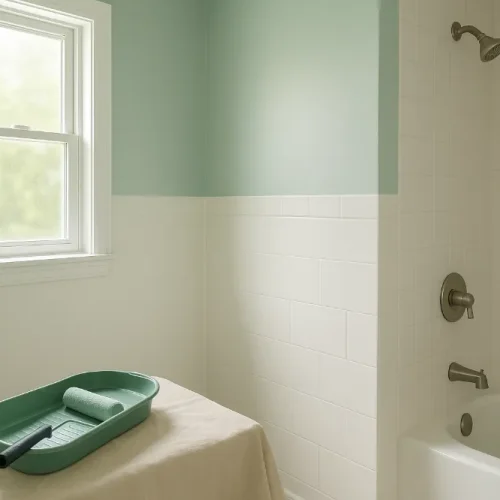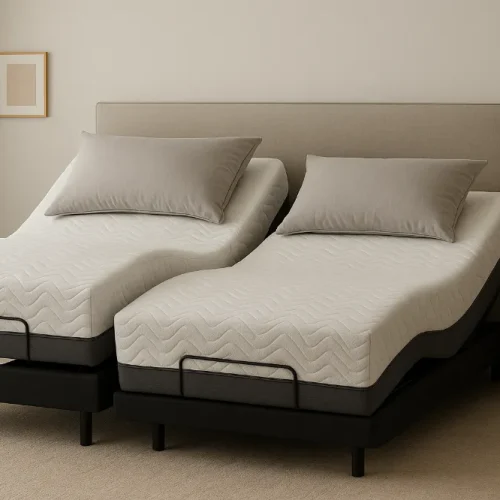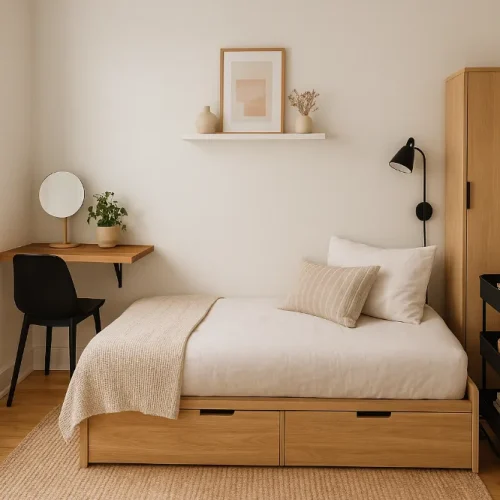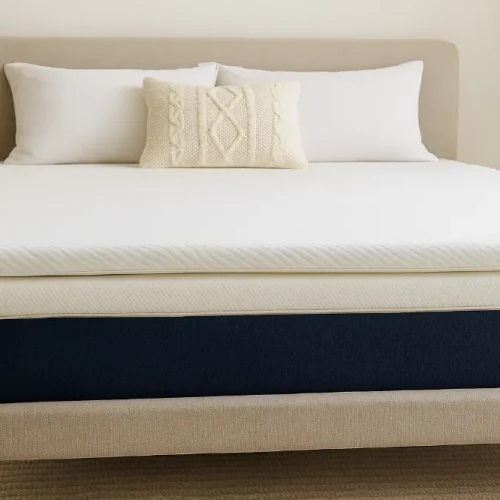Sharing a bedroom sounds simple on paper two people, one room, one bed, and a mutual goal of getting some decent rest. But anyone who has ever shared a sleeping space knows that sleep is deeply personal. It’s influenced by habits, temperature preferences, noise sensitivity, design choices, and biological rhythms that vary wildly from person to person. According to the U.S. Department of Health & Human Services, sleep needs and patterns differ significantly between individuals, which is one reason couples often struggle to sleep well in the same conditions.
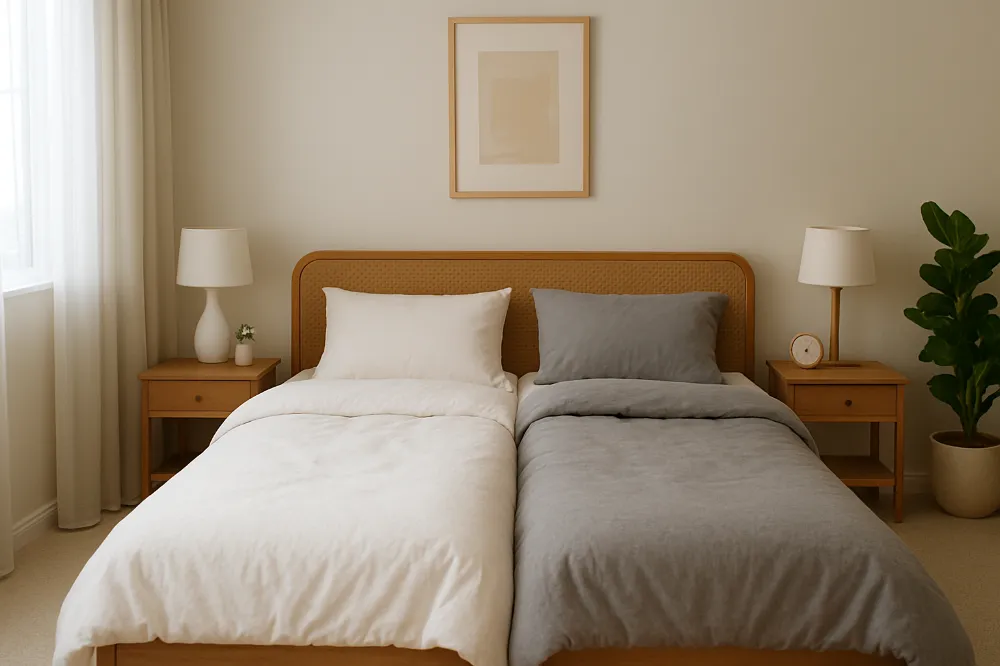
Over the years, I’ve come to believe that personalized sleep arrangements aren’t just a “nice-to-have.” They’re a form of respect a quiet acknowledgment that two people can love each other deeply while still needing to snooze in completely different ways. And the truth is, the more couples I talk to, the more I realize that personalized sleep setups aren’t about separation they’re about sustainability. They’re about making shared bedrooms functional, comfortable, and actually restful for both people. Today, I want to dive deeper into this topic from an honest, personal place how shared bedrooms can evolve beyond the traditional one-size-fits-all model and become spaces that genuinely support two unique sleepers.
The Myth of “One Bed Fits All”
Growing up, I absorbed the idea that couples should share the same bed, same sheets, same pillows, same everything. But what no one mentioned is how unrealistic this is for most people.
One person runs hot.
The other runs cold.
One tosses and turns.
The other sleeps like a stone.
One needs total darkness.
The other scrolls TikTok until midnight.
The assumption that one shared setup can satisfy two different humans ignores a simple reality: sleep is biological, not symbolic. As Wikipedia’s general overview on sleep explains, temperature, comfort, light, and noise all influence sleep quality (https://en.wikipedia.org/wiki/Sleep). So expecting two people with different sensitivities to feel equally rested under one blanket setup is like expecting them to have identical taste buds. Shared bedrooms don’t have to be uniform to feel intimate. Often, personalization is what keeps things peaceful.
Understanding Your “Sleep Personalities”
Before personalizing anything, it helps to understand how you and your partner actually sleep. I call these “sleep personalities” not scientific, but definitely recognizable.
Some sleepers are:
• The Furnace vs. The Glacier
One radiates heat. One hoards blankets like winter is coming.
• The Light Sleeper vs. The Deep Sleeper
One wakes up when someone blinks too loudly. The other sleeps through thunderstorms.
• The Early Bird vs. The Night Owl
Internal clocks don’t always sync up, which can create tension around bedtime routines.
• The Sprawler vs. The Compact Sleeper
One person sleeps starfish-style. The other never leaves their side of the bed.
• The Still Sleeper vs. The Acrobat
For some people, sleep is stationary. For others, it’s an extreme sport. Knowing your differences isn’t about pointing fingers it’s about building a bedroom that works for both people, not just one.
Why Personalized Sleep Setups Sometimes Trigger Emotions

A topic that rarely gets discussed is how emotional sleep-related changes can feel.
Some people worry that:
- “Separate blankets mean we’re drifting apart.”
- “Two mattresses make us feel like roommates.”
- “If we personalize too much, are we distancing ourselves?”
These thoughts are common and totally valid. Society romanticizes the idea of couples sleeping wrapped around each other all night. But anyone who has actually slept like that knows it’s more fantasy than reality. What I’ve learned is this: good sleep strengthens relationships. Poor sleep magnifies stress, irritability, arguments, and resentment. When you personalize your sleep environment, you’re not creating space between you you’re creating comfort, which ultimately fuels connection.
Bedding Personalization: Small Changes, Massive Results
If there’s one area that creates instant improvement, it’s personalized bedding.
Separate Blankets
This might be the simplest and most life-changing upgrade. No more tug-of-war. No more one person sweating while the other freezes. Each person gets what they need without compromise.
Pillow Customization
Pillows aren’t meant to match they’re meant to fit. Height, firmness, fill material, and support should be tailored based on sleeping position and body mechanics. A mismatched pillow set often leads to neck pain, snoring, and restlessness.
Split Toppers
If you share a mattress but need different firmness, split toppers give each person control. It keeps the bed looking cohesive while supporting two bodies differently.
Layered Bedding Styles
You can still create a unified aesthetic with coordinated colors or textures even if what’s underneath differs.
The Rise of Split Mattresses and Why They’re Not “Unromantic”
One of the most misunderstood sleep innovations is the split king. People assume it’s for older couples or those with medical needs, but honestly, it’s perfect for anyone who values rest.
Each person gets:
- Their own firmness
- Their own support structure
- Their own ability to move without disturbing the other
And with the right bedding, it looks like one big mattress. Add adjustable bases, and things get even better. One partner can elevate for snoring relief or reading while the other stays flat. You don’t have to move as one unit. It’s personalized independence without sacrificing togetherness.
Managing Light and Noise Differences
Noise and light sensitivity vary widely between people, and mismatched needs can create friction in a shared bedroom.
Here are sleep-friendly personalization options:
For Light Differences:
- Sleep masks
- Dimmable lamps
- Warm amber bulbs
- Clip-on book lights
For Noise Differences:
- White noise machines
- Earplugs
- Foam headband sleep headphones
- Soft fans
- Heavier curtains
If snoring is an issue, elevating the head, using anti-snoring pillows, or even sleeping at a slight incline can make a huge difference.
Temperature: The Eternal Couple Conflict
Temperature issues are practically universal. Almost every couple I know argues about room temperature or blankets at some point.
Here’s what helps:
- Separate blankets with different weights
- Dual-zone heated blankets
- Cooling or gel pillows
- Personal bedside fans
- Cooling mattress pads
- Thermostat cycling at night
It’s not about finding one temperature that works for both it’s about building a microclimate for each sleeper.
Rethinking Sleeping Positions
This might be controversial, but: you don’t need to sleep intertwined to feel close. Some couples cuddle during wind-down and then go their separate ways when it’s time to sleep. Some start apart and drift together. Some need distance the whole night and make up for it with intentional closeness during the day. There’s no “wrong way” to do this. It’s about protecting sleep quality while nurturing connection.
Separate Sleep Areas: The Choice No One Talks About
A small but growing number of couples sleep in separate beds or even separate rooms and they’ve never been happier.
This choice isn’t about emotional distance. It’s practical for:
- Snoring
- Insomnia
- Restless Leg Syndrome
- Shift work
- Drastic temperature differences
- Chronic pain
- Light or noise sensitivity
Couples who do this often say they feel better, fight less, and actually enjoy their together time more. Intimacy doesn’t disappear just because sleeping arrangements evolve.
Designing a Cohesive Bedroom With Personalized Elements
Even with customized setups, your bedroom can still feel unified and stylish.
Some simple design tricks:
- Symmetrical nightstands
- Bedding in the same color palette
- A wide shared headboard
- A decorative throw placed across both sides
- Matching bedside lamps
- Layered textures and fabrics
It’s all about balance. Even if the functional elements are tailored to each person, the overall aesthetic can be cohesive.

Final Thoughts: Personalizing Sleep Is Personalizing Love
Over time, I’ve realized that personalized sleep arrangements aren’t about separation they’re about understanding. They’re about caring enough to adjust the environment so both people feel good waking up.
There is no one correct way to sleep as a couple.
Maybe you share one blanket.
Maybe you use two.
Maybe you cuddle.
Maybe you don’t.
Maybe you use earplugs.
Maybe you have a fan blasting.
Maybe you sleep on a split king.
Maybe you sleep in separate zones.
The beauty is, you get to design the arrangement that works for you not the one society insists is “normal.” Because at the end of the day, the goal isn’t to match your sleep habits… It’s to protect your rest so you can show up for each other with energy, kindness, and presence. And if a personalized sleep setup helps make that happen, then it isn’t just a sleep choice it’s an act of love.
FAQs
Because sleep is biological, and factors like temperature, light sensitivity, and firmness needs vary from person to person.
Yes separate blankets often improve sleep quality and reduce nighttime disturbances, which can strengthen the relationship.
Not at all. Split setups simply allow each partner to personalize comfort while still sharing a unified bed.
Use matching colors, textures, or a shared throw to maintain a clean, unified look.
Try elevation, anti-snoring pillows, white noise, or personalized sleeping positions to manage the disruption.
Yes each person can control their side independently for comfort without affecting the other.
Separate blankets, cooling pillows, dual-zone bedding, or personal fans work well for mismatched temperature needs.
Yes, and many couples report better rest and improved daytime connection when they do.
Start with individualized pillows and separate blankets they offer big benefits with minimal change.
Absolutely. Use sleep masks, dimmable lights, clip-on reading lights, or blackout curtains.


